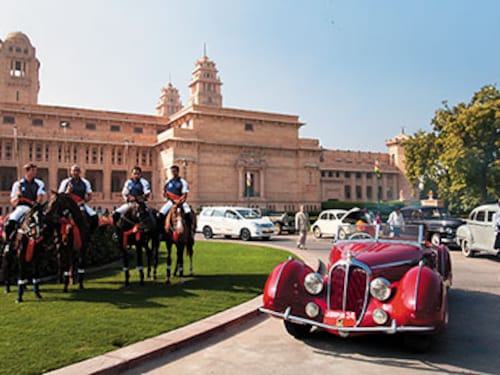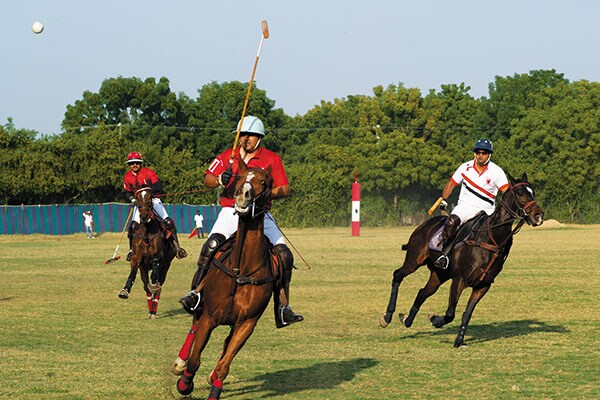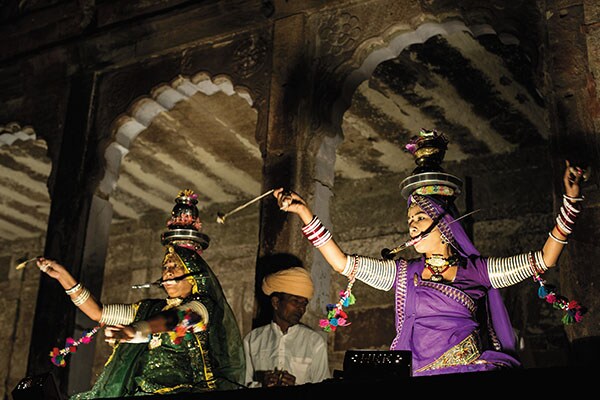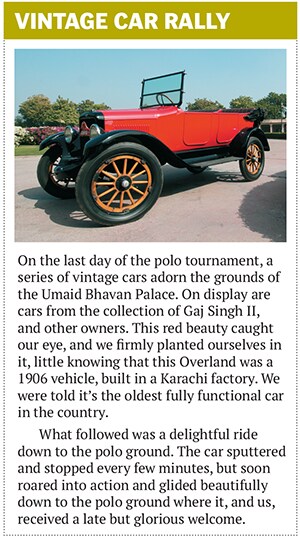In Jodhpur, Polo Blends with Royalty Every Winter
Every December, Jodhpur plays host to some very fine polo, and people


Jodhpur’s airport shares its landing strip with the Indian Air Force. It is what airports of holiday destinations should be: No separate arrival gates, luggage carousels and pick-up points you saunter from the aircraft, winter late-morning sun on your back, to a two-storey terminal building smothered by the most delightful array of bougainvillea.
By the time I have checked in to the hotel, showered away the lack of sleep and taken myself to the polo ground, the semi-final of the Maharaja of Jodhpur Golden Jubilee Cup is well under way. I had never been one for polo all I knew was that it had horses, riders, mallets, and a ball. And that, according to some accounts, it originated in Manipur.
But, by the time I walk from the parking lot to the Royal Salute pavilion at the polo ground, I could not take my eyes off the action on the field. I didn’t know who was playing who, what the score was, or who was winning. All I saw—and gaped at—were the magnificent horses thundering down the ground in the mellowing sun of the late afternoon, hooves kicking up dust, riders swinging long mallets, manoeuvring the massive animals after the small ball with the skill of La Liga footballers.
Over the rest of the evening, and the day after, I got a crash course in the rules of polo, and up close to the emotions and events that lends the Jodhpur polo tournament a rather generous touch of class.
Polo, I learn, has half points while counting goals. So, a team can have, say, eight-and-a-half goals. A not-so-complicated formula is used to determine the ‘handicap’ of a team, which is then added (in wholes, halves or both) to the score. Each team comprises four players: Numbers 1 and 2 are forward positions, 3 is the midfielder, and 4 brings up the rear. I learn that infringing on the line of play results in a foul (this is easier said than done because of the frenetic pace of the sport, and the fact that players are not controlling their own movements as much as that of their mounts). Fouls, of course, result in penalties. 
The final match between IPG Bedla and Central Academy
I also learn that players change their mounts between chukkas (oh, a game is divided into chukkas of seven-minutes each the number of chukkas in a game may vary) because the horses need to be rested major polo events, like the ones in Argentina, require a rather large number of horses. No, players don’t travel with their horses any longer they used to, when travel was not what it is today. And who takes care of all these horses? There is a village full of grooms close to the polo ground at Jodhpur who have done just this for generations.
If I had thought the semi-finals were exciting, the finals on the following day had me hooked. IPG Bedla, comprising ex-students of Mayo College, took on Central Academy in a match that had the spectators on the edge of their plush seats. In the first half, Central Academy seemed to be running away with the trophy, scoring six goals against IPG Bedla’s 1.5. The commentator even wondered if the score could be surmounted.
What we then witnessed was not far short of a miracle, with IPG Bedla scoring 6 goals, including 3 in 90 seconds, ripping apart the script and tearing the stuffing out of the bemused Central Academy team. Although the Academy boys (they are always ‘boys’, for some reason) fought back and got within a half-goal of Bedla, the match ended with them managing 7 goals to Bedla’s 8.5.
It was exciting, very exciting. The commentator repeatedly asking the spectators—including large numbers of locals, and not just the posh, celebrity-type guests—to move away from the edge of the field to avoid being run over by the charging horses the spectators roaring at each goal, each miss, each foul a couple of local hounds—accustomed to lolling on the grass on other days—scampering out of the horses’ way on multiple occasions cameramen furiously switching between cameras or lenses to keep adjusting to the movement and distances before they miss a good shot.
While it is good when you don’t really support any particular team and are simply happy to be swept up by the frenzied energy, it is even better when you do support a team, and see them put up a spectacular performance.
Polo and Jodhpur have shared a very strong bond since the 19th century: In 1889, Maharaja Pratap Singh invited Colonel Stuart Beatson of the Bengal Lancers to help raise the standard and profile of the local polo team, the Jodhpur Lancers. In 1897, Pratap Singh took his team to England, where their performance against the home teams made people sit up and take note.
But what put the polo teams of Jodhpur and Jaipur firmly on the world polo map was their performance in England in the 1930s. “The Jaipur team took all the tournaments they entered in the 1933 London season, a feat that can perhaps be equalled but never bettered,” wrote Horace A Laffaye in The Evolution of Polo. “Hotter than mustard,” is what the British tabloid press called the Indian teams.
With India’s independence, the abolition of the princely states and the consequent shifts in political and social structures, it was not until 2000 that modern-day polo returned to Jodhpur. Gaj Singh II, the present head of the erstwhile royal family, carved out a new grass ground in the shadow of the Umaid Bhavan Palace in 1997 he is also the ambassador and founding patron of the Jodhpur Polo and Equestrian Institute.
“Polo,” Gaj Singh says, “is not just an instrument to promote tourism in Jodhpur it is an integral part of the heritage and legacy of this place. It is the friendliness of this place that makes it different from other polo destinations—like Argentina, where money power and man power overtakes the sport. Here, it is not that competitive.”
However, opportunities for expansion are welcome. “I would like more people to come for the tournaments, but logistics are a problem. There would, then, be the possibility of extending the season, instead of cramming it into one week.”
The touch of royalty, of course, goes a long way in promoting the sport. “The special blend of power, charm and charisma is something that is very appealing,” says Peter Prentice, the heritage and brand experience director for Chivas Brothers, parent company of Royal Salute.
The position of the royalty in independent, democratic India is one that continues to evoke curiosity. “It is a double-edged sword, a mix of curiosity and respect. There are people who think, ‘Who are these people?’… but those born in independent India don’t have prejudices,” adds Gaj Singh. “They go to the [Mehrangarh] fort and get impressed. They realise how the fort would have been if it was left in government hands.”
Calling Mehrangarh impressive would be putting it mildly.
Being told that the Maharaja of Jodhpur Golden Jubilee Cup culminates in a gala at the fort was not enough to prepare me for the spectacle on display. The stately procession of guests and hosts—finery rustling, champagne flutes clinking, laughter tinkling—glided through high, arched gateways, past medieval walls burnished gold by a hundred flaming torches, amid flagbearers, decorated camels and their mahouts.
Turn a bend, and we are in a courtyard. Above us, a pillared verandah with arches, and… oh, what colours, what music. Behind the pillars are a group of women dancing the ghoomar—a spellbinding swirl of brilliantly coloured lehengas, tassels and dupattas—as musicians and singers sit behind them on the floor, their voices stirring up the cold winter air as much as the whirl of fabrics.
The walk continues past more walls, more archways, more flaming torches, and more steps. Round another bend are a pair of kalbelia dancers, sitting along a ledge they have small brass bells tied along the length of their legs their hands, in which they hold the other halves of those bells, move in unison, each movement striking one specific bell on their legs. They move—with speed, grace and precision—to the song of musicians, while creating their own music as they strike the right bells in perfect harmony.
Flame throwers and fire eaters entertain guests in a corner, while another folk dancer, ghungroos around her ankles, puts up a performance while balancing an ever increasing number of steel gharas on her head. Every time you think the towering gharas can’t get higher, she ups the stakes with another one. And, finally, she steps over a pair of daggers, edges turned upwards, for her last act. The guests go wild they cheer and clap as the dancer takes a bow.The walk ends on a terrace that overlooks the city. And at this time of the night, it’s not the famous blue walls of the city below that you see, but its sparkling lights. The evening proceeds with more music and dance.
The highlight of the evening is a performance by Karsh Kale, who presented The Karsh Kale Ensemble, featuring guitarist Warren Mendonsa, flautist Pandit Ajay Prasanna, drummer Jai Row Kavi, Jayant Luthra on electronics and singer Shilpa Rao. Performing to their genre-bending music was the Natya Nectar Dance Company, with a fusion of Indian classical and folk dance forms and acrobatics.
Watching the performance, dining on age-old recipes of the royal kitchens, the glowing embers of royalty dotting the night around me, the fort ramparts keeping out nothing but the cold desert wind, I wonder how far time has travelled within these centuries-old walls.
There are performers, as there always were at royal courts, but now they play electronica you spot the incongruous pair of sneakers on a flag-bearer otherwise turned out in traditional fare or the Bollywood-inspired pink bodice atop the traditional costume of the ghara dancer you walk through showers of rose petals descending from windows above, and yet you notice the tired face of an ageing guard at one of the gateways through which the rich and famous pass inside the Umaid Bhavan Palace is the splendour and beauty of royal tastes, while outside there are new apartment blocks coming up on the palace’s threshold.
Shakespeare’s Rosalind had famously said “time travels at diverse paces with diverse persons”. In Jodhpur, you know she was right.
(The writer was a guest of Royal Salute, which paid for both stay and travel.)
First Published: Feb 03, 2014, 07:41
Subscribe Now